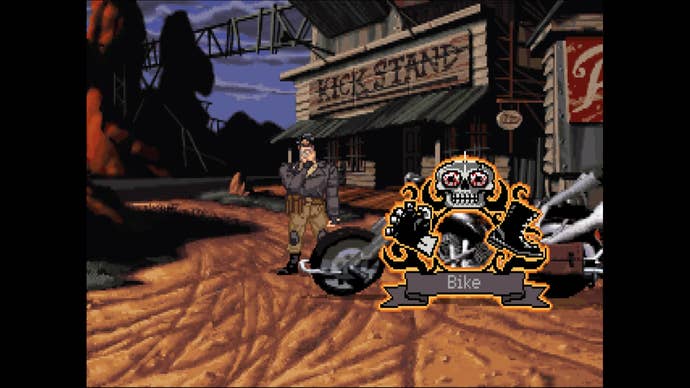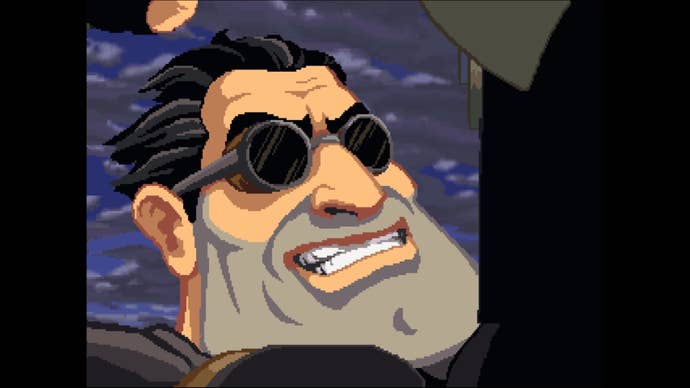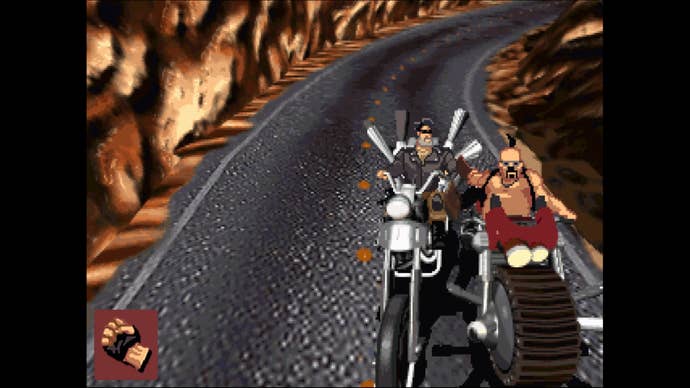Full Throttle Remastered Review
Easy rider.
This article first appeared on USgamer, a partner publication of VG247. Some content, such as this article, has been migrated to VG247 for posterity after USgamer's closure - but it has not been edited or further vetted by the VG247 team.
By the year 2022, we might finally have flying cars buzzing over our homes. The vertigo-inducing future of transportation imagined in the science fiction of everything, from Blade Runner to Back to the Future, is (at last) well on its way. But I wonder, if the hover cars of the future coast their way into existence, then what does that mean for the rest of transportation? I have no idea. But Tim Schafer might.
Full Throttle imagines a future more nostalgic. Where hover cars exist, but so do wistful bikers. The stubborn type that don’t take anything without wheels for an answer. Where the last remaining motorcycle company is at risk of becoming—gasp—a minivan company, and that in itself is a catastrophe that must be stopped. Even if hover cars weren’t a distant fantasy back in 1995 when Full Throttle was originally released, it can’t help but feel prescient playing a game that roots itself in a probably not-too-far-off future.
I should get this out of the way before I continue: this was my first time playing Full Throttle. Yes, as someone who loudly proclaims Grim Fandango and The Secret of Monkey Island as some of her all-timers, who often truly misses the adventure games of the past (even if some creators are recapturing the magic)—Full Throttle has somehow evaded my purview all these years. But I guess that changed this week, when Full Throttle’s newly remastered edition dropped into my lap.
In Full Throttle, the player is pit as Ben. Ben’s the stoic leader of a local desert-bound biker gang. The highway is his home; his gang comrades are his friends; his bike is his one true love. That is, until Ben is on the run after being framed for murder. His goal: clear his name, save his biker gang, save motorcycles (for the love of wheels!), and look cool while doing it all. Ben meets some friends along the way, and clicks a lot of stuff.




Full Throttle feels at once familiar and unfamiliar to players of adventure games. Charmingly abstract puzzles are traded for (frankly) terrible action sequences. It’s far more cinematic in its visuals than most adventure games attempted back in its era, as if director Tim Schafer and co. watched Peter Fonda coast across the country in Easy Rider and thought, "Let’s do that, but take out all the drugs." It retains the beloved snark and attitude of Day of the Tentacle, The Secret of Monkey Island, and Maniac Mansion. It keeps the quirky, memorable characters that made those games so worthwhile. (Ripburger, voiced by Mark Hamill, is an excellent devilish scumbag.)
It still feels like it’s missing that umph though. The puzzles in Full Throttle are parsed down, resigned to throwing meat in a car to distract a dog, rather than testing a player’s lunatic adventure game logic. Maybe this was an intentional slight, meant to mirror Ben’s no bullshit attitude; but for a LucasArts classic, it felt disappointingly bland. The action sequences, including some timed moments (with no clock indicator in sight) and a bit that has you speeding round and round in a big loop fighting other bikers, are frustrating in their design. Riding around the encircled Mine Road, fighting bikers as they roll alongside you in an attempt to land a pair of goggles feels determined on luck. With the timed sequences, plotting out a puzzle with no clock indicator even noting how much time I had left led to repeated frustrated restarts.

Full Throttle, like director Tim Schafer’s recent remasters of his adventure classics, remains both untouched and retouched. There’s notable additions to the game: the always appreciated commentary track, the fluidity with which one can switch between the classic pixelated game and the freshly redrawn widescreen version. If you want the classic experience, crunchy audio and all: it’s there. If you want the new experience, well, that’s there too. For me, I dabbled in both, switching seamlessly throughout the game’s highway-bound tale (though retaining the updated, crisper audio almost always).
And what I found was that the pixelated version was actually preferable, in spite of its shortened aspect ratio (similar to the other "classic" options in DoubleFine’s other remastered titles). The redrawn scenes erred too much on the side of Flash animations—a style I personally abhor (and a problem I had with the freshly painted-look of the Day of the Tentacle remaster). The pixel art, however, still stands strong today. When the camera closes in on Ben’s incredibly expressive face during close-ups, or the fire chaotically bursts out of his hog. It’s kind of a marvel, really, considering similar pixelated games of the early-to-mid 1990s.
We probably won’t be flying cars in a few years, like whatever that start-up company insists. But if we were, there’d probably be a Ben around, grasping at the Golden Age of Wheels. He’d make his way across the desert, maybe to Mardi Gras like Peter Fonda once did. Maybe to stop an evil corporation from eradicating the last semblance of pre-futuristic society forever. In the meantime, we have the charming but flawed Full Throttle, crisper than ever. Time to smell that asphalt.
InterfaceThe interactive UI, eye-popping skull and all, is a clever way to mask typical point-and-click interactions.
SoundIn typical Double Fine remastered form, both the original unpolished audio and remastered audio is available. (I recommend the latter, for obvious reasons.)
VisualsOf all of Tim Schafer's classic adventure games, Full Throttle deserved a visual upgrade the least. For its time, it wielded cinematic scenes with detailed pixel art that even today looks impressive. By reanimating the scenes with flat 2D art, the game just looks like an unremarkable, forgotten Flash game. Luckily though, that old version is perfectly playable as well.
ConclusionFull Throttle has a great cast of characters and atmosphere, but with its remaining irritating action and timed sequences, bland puzzles, and an unnecessary fresh paint job, the game carries its old flaws to a new generation, and ushers some new ones in as well. Luckily, with the seamless swap to its already-fantastic original pixel art (whose immense detail is commendable, even in 2017), clicking through Full Throttle's charming love letter to wheels is still pleasant.

